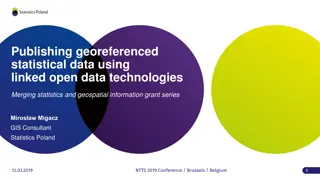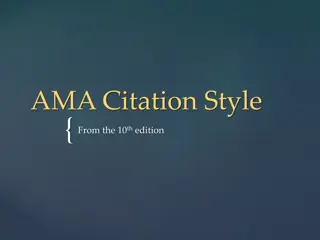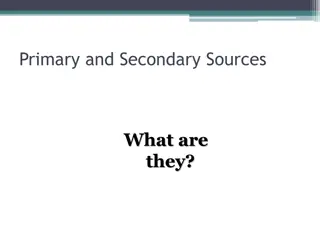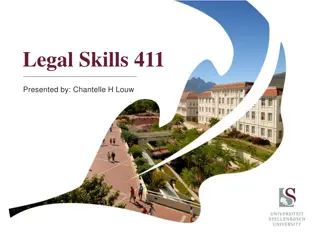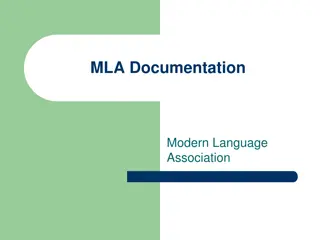Chapter 2: Beginning a Research Project
Explore research topics, question creation, and finding information sources. Engage in a debate on legalizing marijuana and practice citing literature sources. Discover various credible resources for social work research.
4 views • 17 slides
Historical Sources as Evidence
Explore the importance of historical sources as evidence in the Victorian Curriculum History context, focusing on how students analyze, evaluate, and utilize sources to create historical explanations and arguments. Discover the significance of primary and secondary sources, perspectives of historica
2 views • 46 slides
Meta Paraphrasing: A Teaching Strategy for Learning and Practicing Paraphrasing
Paraphrasing is a vital skill that demonstrates understanding, allows integration of ideas ethically, and enhances credibility. This strategy involves proper analysis, using one's words, and citing sources accurately to avoid plagiarism.
5 views • 18 slides
Sources of Drugs and Their Origins
Drugs can be sourced from six major categories: plants, animals, minerals/earth, microbiological sources, semi-synthetic sources, synthetic sources, and recombinant DNA technology. Plant sources, being the oldest, provide various medicinal properties through leaves, flowers, fruits, seeds, roots, ba
1 views • 11 slides
The Importance of Citing Sources in Chicago Style
Citing sources in Chicago Style (17th edition) is crucial to credit authors, avoid plagiarism, and provide readers with access to your research sources. This guide covers why to cite, when to cite, citation styles, Chicago Style notes and bibliography, in-text and endnotes, and creating a bibliograp
0 views • 10 slides
The Oxford University Standard for Citation of Legal Authorities (OSCOLA) Overview
OSCOLA is a citation standard designed for legal authorities to enhance consistency and ease of reading. It provides guidelines for citing cases, legislation, and secondary sources, aiming for simplicity and practicality.
1 views • 21 slides
Information Literacy: A Comprehensive Guide for Students
Information literacy is crucial for academic success. It involves the ability to recognize the need for information, locate relevant sources, evaluate their credibility, and effectively use the information for research and presentations. Primary and secondary sources play a vital role in gathering i
2 views • 19 slides
MLA Style Formatting Guidelines
MLA Style, established by the Modern Language Association, is commonly used in humanities disciplines. The 8th edition introduces principles for citing sources and covers aspects like document formatting, in-text citations, works cited lists, and more. This presentation provides an overview of how t
0 views • 43 slides
Bluebook Guide for Law Reviews and Journals at Penn State Law
The presentation provides a detailed overview of the Bluebook rules and formatting conventions for citing legal sources in law reviews and journals, specifically tailored for Penn State Law students. It covers proper citation forms, typeface conventions, and examples for main text and footnote citat
1 views • 105 slides
Plagiarism: Types, Examples, and Prevention Techniques
Plagiarism is a serious academic offense that involves using someone else's work without proper acknowledgment. This publication delves into the different forms of plagiarism - intentional and accidental, such as self-plagiarism, and provides examples to help readers understand what constitutes plag
0 views • 21 slides
The Economics of Green Tax Shift for Climate Change Mitigation
The concept of a Green Tax Shift involves implementing market mechanisms like carbon taxes to reduce greenhouse gas emissions without harming living standards. Economists support this approach, citing its benefits in slowing climate change and improving productivity. The strategy involves focusing o
0 views • 15 slides
Mastering Source Citation Techniques for Research and Assignments
Explore the essential elements of referencing styles, including in-text citations and reference lists. Learn how to credit sources properly, cite ideas and theories, and direct readers to full source details. Understand the rules for citing authors, quoting specific parts, and referencing multiple a
2 views • 12 slides
Accelerator Technology R&D Targets and Sources Overview
The SnowMass2021 Accelerator Frontier AF7 focuses on Accelerator Technology R&D, exploring targets and sources such as high brightness electron sources, muon sources, and high intensity ion sources. The community planning meeting discussed various Letter of Interest submissions outlining innovative
1 views • 7 slides
Ethical Research Guidelines and Citation Best Practices
Learn how to conduct ethical research with guidelines on finding reliable sources, taking notes without plagiarizing, and creating a works cited page using tools like Citation Machine. Avoid plagiarism by properly citing sources and organizing research information effectively.
3 views • 10 slides
Effective Strategies for Tackling History Exam Questions
Discover targeted approaches for answering specific History exam questions, including analyzing features, evaluating sources, citing evidence, comparing periods, explaining reasons, and forming arguments. Tips range from describing features of a topic in Whitechapel to evaluating source usefulness a
1 views • 8 slides
Early American Literature: Citing Evidence and Analyzing Texts
Delve into Early American Literature with a focus on citing textual evidence, analyzing complex ideas, and exploring essential questions. Understand the standards in reading and writing while enhancing vocabulary and grasping implicit versus explicit meanings in texts.
0 views • 27 slides
Development of Guidelines for Publishing Georeferenced Statistical Data Using Linked Open Data Technologies
Development of guidelines for publishing statistical data as linked open data, merging statistics and geospatial information, with a primary focus on preparing a background for LOD implementation in official statistics. The project aims to identify data sources, harmonize statistical units, transfor
3 views • 31 slides
AMA Citation Style Guidelines from the 10th Edition
AMA Citation Style from the 10th Edition outlines specific formatting rules for academic and research writing. It covers aspects such as numbering systems, in-text citations, reference list organization, and writing conventions. The guidelines provide a comprehensive framework for citing sources and
0 views • 8 slides
Reliable and Unreliable Sources for Research
Recognize reliable and unreliable sources for research. Reliable sources, such as books and peer-reviewed journals, are authored by experts in the field. Unreliable sources like Wikipedia and blogs can be altered by anyone. Learn how to evaluate the credibility of online sites based on their URLs an
0 views • 10 slides
Plagiarism and Academic Negligence in Academic Writing
This content discusses the definitions of plagiarism and academic negligence, the importance of citing sources, and the consequences of academic dishonesty according to the LCC Student Code of Conduct. It emphasizes the necessity of acknowledging sources to give credit, establish credibility, and av
0 views • 32 slides
Plagiarism Prevention Tutorial: How to Avoid Common Forms of Plagiarism
This tutorial by Dr. Kosha Bramesfeld provides valuable insights on understanding, preventing, and avoiding plagiarism. Learn about the various forms of plagiarism, the importance of citing sources, using APA style, paraphrasing, and creating references to maintain academic integrity. Avoid the seve
0 views • 78 slides
APA Citation Rules and Examples for PowerPoint Presentations and Oral Presentations
Learn how to correctly cite sources using APA format in PowerPoint and oral presentations. Understand the rules for citing one author, two authors, multiple sources, and more. Utilize examples to see how to format in-text citations within slides effectively. Additionally, discover tips on incorporat
0 views • 5 slides
Mythical Creatures Research Project Overview
Students in 6th grade will be assigned a research paper on mythical creatures. The project includes a detailed scoring rubric, mandatory and elective questions, web sources, and guidelines for citing sources. The students will use NRMS iPads and/or other approved technology for research. The due dat
0 views • 8 slides
Citing Sources in Research Papers: A Comprehensive Guide
Learn how to correctly cite sources in a research paper through parenthetical citations and creating a Works Cited page. Understand the importance of giving credit to sources to avoid plagiarism. The guide covers the use of quotations to strengthen your arguments, parenthetical citations from specif
0 views • 6 slides
Primary and Secondary Sources in Research
Primary sources provide firsthand information from the time period being studied, while secondary sources offer interpretations based on primary sources. Examples of primary sources include autobiographies, speeches, historical documents, published firsthand accounts, and sound recordings. Secondary
0 views • 23 slides
Enhancing Early Childhood Research Skills
Explore the importance of effective research in early childhood education, learn to discern legitimate and current information, and discover evidence-based practices. Gain insights on citing sources in APA style and identify reliable websites for research. Engage in activities to apply research skil
0 views • 12 slides
Modern Language Association (MLA) Guidelines for Quoting and Citing Literary Genres
Learn how to properly quote and cite literary genres following the MLA Handbook for Writers of Research Papers. Explore guidelines for citing authors in parenthetical citations and incorporating prose quotations into your text, including handling question marks and block quotes.
0 views • 16 slides
International Inventory of Musical Sources by RISM
Founded in Paris in 1952, the Répertoire International des Sources Musicales (RISM) comprehensively documents existing music sources worldwide. Recognized as the key entity for cataloging music sources globally, RISM's working groups in over 35 countries catalog manuscripts, printed music, writings
0 views • 17 slides
Guidelines for Avoiding Plagiarism in Legal Studies
Understanding and implementing proper citation practices is crucial to avoid plagiarism in legal studies. The guidelines presented emphasize the importance of citing sources, whether it be ideas, words, or previously published work. Failure to attribute sources properly can result in academic miscon
0 views • 14 slides
Effective Techniques for Incorporating Source Material in MLA Documentation
Paraphrasing plays a crucial role in research writing, with 75% of research material recommended to be paraphrased. Validating your sources by acknowledging their credentials is essential. Understanding attribution verbs and correctly citing sources using parenthetical citations and corresponding en
0 views • 24 slides
Disused Sources Working Group Report on National Security Perspective
The Disused Sources Working Group (DSWG) report focuses on managing and disposing of sealed sources to reduce national security risks. Formed in 2011, DSWG developed recommendations to enhance the management of disused sealed sources. The report categorizes sealed sources based on potential harm and
3 views • 15 slides
Effective Use of Quoting and Paraphrasing in Academic Writing
Learning when to quote and when to paraphrase in academic writing is crucial for credibility. Quotations should be used sparingly, with attribution and relevant introductions. Signal verbs like acknowledges, claims, and more enhance attribution. Citing sources effectively adds credibility to your wo
0 views • 12 slides
Plagiarism: Citing Sources Ethically
Plagiarism is a serious offense that involves stealing ideas or words without proper attribution. Learn about the definition of plagiarism, Plymouth State University's plagiarism policy, and examples of plagiarism. Understand the importance of crediting sources and avoiding academic dishonesty.
0 views • 20 slides
Mastering Literary Analysis: Essential Guidelines and Examples
Learn the importance of using the literary present tense, citing sources accurately, and referencing authors correctly when analyzing works of literature. Understand how to punctuate direct quotes and apply in-text citations effectively. Improve your writing skills with practical examples and tips f
0 views • 15 slides
Vulnerability of Radiological Materials to Theft by Terrorist Groups in US Civilian Entities
The vulnerability of radiological materials stored at US civilian entities to theft by terrorist groups, particularly low-activity sources, remains a significant concern. Security measures primarily focus on high-activity sources, leaving lower activity sources neglected and highly susceptible to ex
0 views • 16 slides
Evaluating Sources on Female Rule in the 1550s
This analysis focuses on assessing the reliability and usefulness of historical sources discussing the issue of female rule in the 1550s. It evaluates the content, provenance, and context of the sources to determine their relevance for historians studying the topic. The sources provide insights into
0 views • 8 slides
Activities, Sectors, and Control Technologies in GAINS Research
The GAINS research by Janusz Cofala and Zbigniew Klimont focuses on aggregation criteria for emission sources, macroeconomic parameters such as population and GDP, aggregation of energy-related sources, transport sources, and process sources. It also covers specific VOC processes/sources like solven
0 views • 13 slides
MLA 8th Edition Changes: Basics and Examples
The MLA 8th edition brings changes to formatting entries, emphasizing uniform double-spacing, using quotation marks for articles, and italicizing titles. This guide provides examples for formatting various sources like websites, web magazines, and scholarly journals, including details on citing auth
0 views • 9 slides
Quick Guide to Chicago Notes & Bibliography Citations
Chicago Notes & Bibliography Style, also known as N. & B., is commonly used in humanities fields like literature and history. This system involves citing sources in numbered footnotes or endnotes, with corresponding entries in a separate bibliography. Capitalization rules, author formatting, and exa
0 views • 13 slides
Chicago Author-Date Citations: Quick Guide
Chicago Author-Date Style is commonly used in the sciences and social sciences for citing sources parenthetically within the text by the author's last name and year of publication. This guide provides examples of in-text citations and reference list entries for various types of sources, including bo
0 views • 13 slides
















